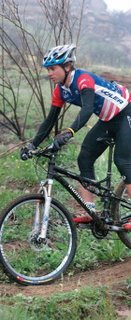Iron Horse Azure World Cup review in Mountain Bike Action
SUSPENSION TYPE: DW-Link.
DESIGNER: Dave Weagle.
CHASSIS DESCRIPTION: Iron Horse’s fresh take on the dual-link arrangement is to configure the linkage to create a line of acceleration that counters the rider’s mass as it lags behind like a pendulum and compresses the rear suspension with each push of the pedals. The DW-Link achieves its “antisquat” pedaling action without the need for platform damping in its shock (although the current production Azure World Cup does use a stable-platform damper). The Azure’s well-built chassis is designed with a conventional hardtail look and a firm, quick-accelerating ride.
SHOCK/SETTINGS: Fox Float R: rebound, 5 clicks in; air spring, 150psi; sag at 25 percent.
FORK/SETTINGS: Fox Float RLT: rebound, 10 clicks in; spring, 80psi.
TRAVEL: Fork, 3.9 inches; rear, 3.5 inches.
PERFORMANCE
The Iron Horse ridden in our comparison is a preproduction version of the Azure. Despite being a couple of pounds over the weight of a true World Cup sled, Iron Horse’s first serious attempt at a pro-level, cross-country machine is impressive. Its technical climbing skills, combined with sharp acceleration, earn high marks for anyone who wants a race-worthy trailbike. The DW-Link suspension remains functional to an appreciable degree under power and braking forces, so it makes good use of its minimal wheel travel. When we set up its Fox fork’s lockout threshold to act as an on-the-fly platform valve, the Azure became the easiest bike of the five to ride. Just get on and go. Iron Horse’s take on dual-link is an effective, set-and-forget system.
RATINGS
Seated pedaling: 9
Feels smooth, efficient and brisk at the pedals in any gear combination.
Out-of-the-saddle acceleration: 8
Surges forward even with a moderate effort. It encourages you to power over rollers without downshifting. A more centered position over the bike minimizes fork bobbing.
Seated climbing: 8
Active rear suspension makes it a good technical climber. Its anti-squat action helps keep you moving in a straighter line. The Giant edges it out in this category.
Out-of-the-saddle climbing: 9
Crisp acceleration with each step on the pedals, and traction always seems to be available. Less need to lock out the fork than with the others.
Small bumps: 7
The Azure handles chatter and small braking bumps well, but anything larger and the ride will turn noticeably harsher.
Big bumps: 7
The DW-Link suspension delivers a smooth, no-bottom feel over G-outs and jumps with its minimal travel. Drop the rear wheel into a deep rut, however, and it will surprise you with a
big thud. Sharp-edge impacts seem to affect the Azure more.
Active under power: 7
Very good suspension action while climbing and accelerating, but there’s just not enough travel to take advantage of this important feature.
Active under braking: 7
There is a bit less suspension action than the Giant has when you pull the brake lever, but the Iron Horse’s centered cockpit weights the rear tire better and reduces skidding.
IRON HORSE AZURE TALLY: 7.75
DESIGNER: Dave Weagle.

CHASSIS DESCRIPTION: Iron Horse’s fresh take on the dual-link arrangement is to configure the linkage to create a line of acceleration that counters the rider’s mass as it lags behind like a pendulum and compresses the rear suspension with each push of the pedals. The DW-Link achieves its “antisquat” pedaling action without the need for platform damping in its shock (although the current production Azure World Cup does use a stable-platform damper). The Azure’s well-built chassis is designed with a conventional hardtail look and a firm, quick-accelerating ride.
SHOCK/SETTINGS: Fox Float R: rebound, 5 clicks in; air spring, 150psi; sag at 25 percent.
FORK/SETTINGS: Fox Float RLT: rebound, 10 clicks in; spring, 80psi.
TRAVEL: Fork, 3.9 inches; rear, 3.5 inches.
PERFORMANCE
The Iron Horse ridden in our comparison is a preproduction version of the Azure. Despite being a couple of pounds over the weight of a true World Cup sled, Iron Horse’s first serious attempt at a pro-level, cross-country machine is impressive. Its technical climbing skills, combined with sharp acceleration, earn high marks for anyone who wants a race-worthy trailbike. The DW-Link suspension remains functional to an appreciable degree under power and braking forces, so it makes good use of its minimal wheel travel. When we set up its Fox fork’s lockout threshold to act as an on-the-fly platform valve, the Azure became the easiest bike of the five to ride. Just get on and go. Iron Horse’s take on dual-link is an effective, set-and-forget system.
RATINGS
Seated pedaling: 9
Feels smooth, efficient and brisk at the pedals in any gear combination.
Out-of-the-saddle acceleration: 8
Surges forward even with a moderate effort. It encourages you to power over rollers without downshifting. A more centered position over the bike minimizes fork bobbing.
Seated climbing: 8
Active rear suspension makes it a good technical climber. Its anti-squat action helps keep you moving in a straighter line. The Giant edges it out in this category.
Out-of-the-saddle climbing: 9
Crisp acceleration with each step on the pedals, and traction always seems to be available. Less need to lock out the fork than with the others.
Small bumps: 7
The Azure handles chatter and small braking bumps well, but anything larger and the ride will turn noticeably harsher.
Big bumps: 7
The DW-Link suspension delivers a smooth, no-bottom feel over G-outs and jumps with its minimal travel. Drop the rear wheel into a deep rut, however, and it will surprise you with a
big thud. Sharp-edge impacts seem to affect the Azure more.
Active under power: 7
Very good suspension action while climbing and accelerating, but there’s just not enough travel to take advantage of this important feature.
Active under braking: 7
There is a bit less suspension action than the Giant has when you pull the brake lever, but the Iron Horse’s centered cockpit weights the rear tire better and reduces skidding.
IRON HORSE AZURE TALLY: 7.75


0 Comments:
Post a Comment
Subscribe to Post Comments [Atom]
<< Home